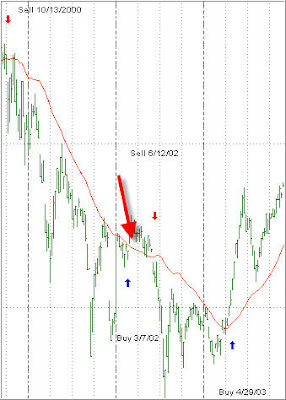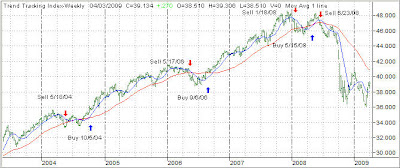Yesterday, I talked about the flattening of the trend line and its potential effect on a buy signal. Today, let’s look at a historical chart of the domestic Trend Tracking Index (TTI) to determine if a rising trend line should you keep you in the market, even though our trading rules signal a ‘Sell.’
Take a look a the graph below, which shows the price action along with our ‘Buy’ and ‘Sell’ signals over the past 6 years: There were 4 sell signals identified by the large red arrows. You can look at each one of them and note that the trend line was still rising when the ‘Sell’ occurred. The first 3 ended up to be whip-saws as the markets subsequently resumed their long-term upward trend. Here’s where percentages can get you into trouble. If you were to conclude that 75% of the time a rising trend line renders a sell signal invalid, then you would be right—until you’re wrong. This is where the magnitude factor kicks in. Had you made the decision to stay in the market and ignore the ‘Sell’ on 6/23/08 as well, your portfolio would be in the same shape as that of the buy-and-hold crowd. Three times you would have been right over 6 years by avoiding a whip-saw, but the fourth time you would have gotten clobbered. My experience from following these trends for over 20 years simply tells me that you can never be sure. I have learned that it is better to live with an occasional whip-saw than to arbitrarily use rising or falling trend lines to fine tune my decisions. The simplicity of following all buy and sell signals regardless of outcome is what will keep you consistently on the right side of the long-term trend; even though at the time it may not always seem that way. If you adopt the long-term view, as I tried to by using these occurrences over a 6-year period, you may find these whip-saws to be nothing more than a necessary evil on your way to safely avoiding bear market disasters. 
[Click chart to enlarge]





